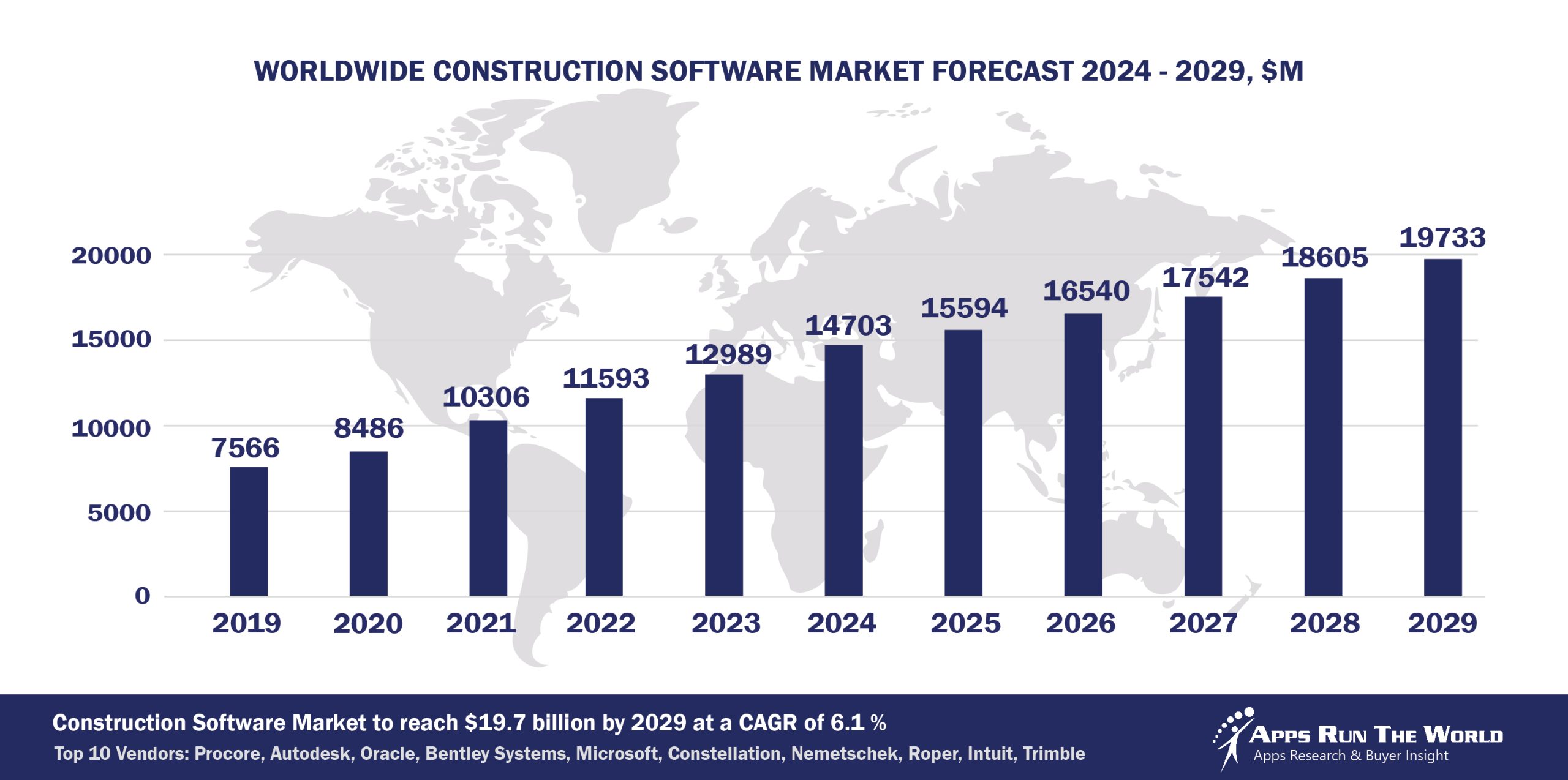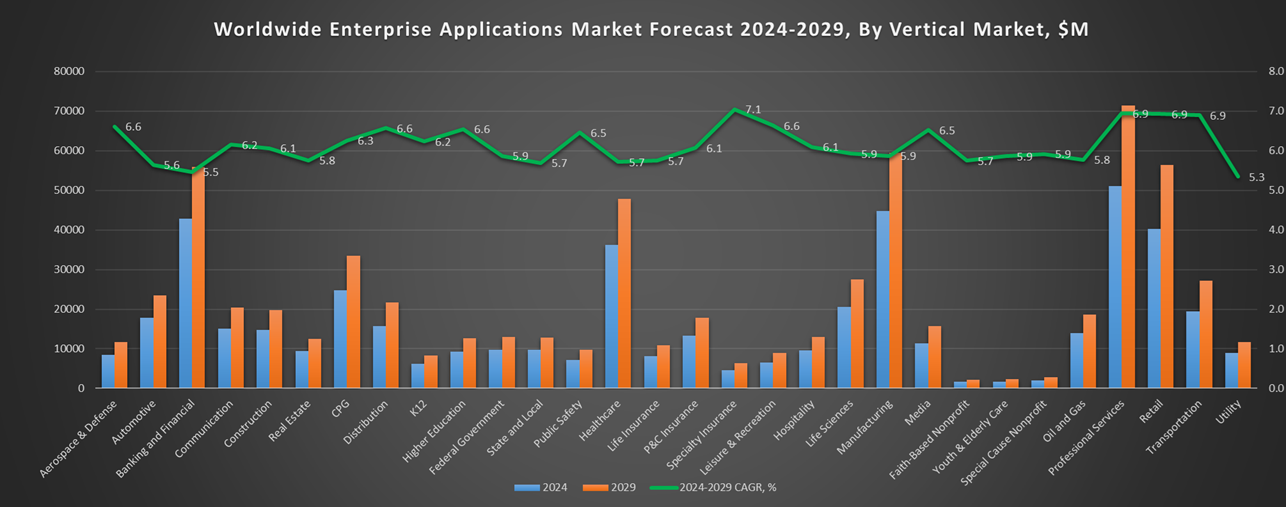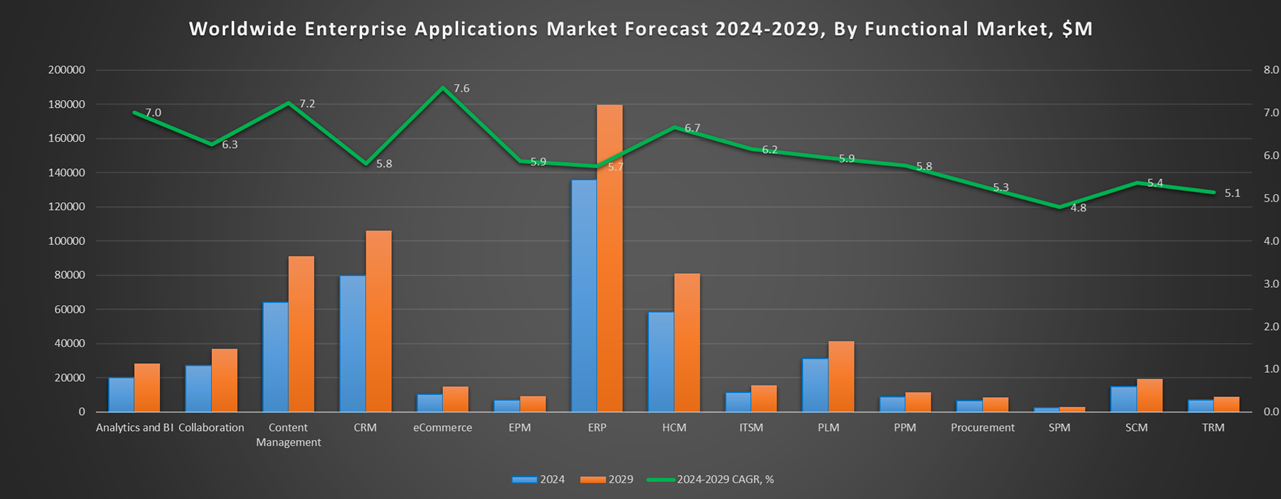
Through our forecast period, the Construction applications market size is expected to reach $19.8 billion by 2029, compared with $14.7 billion in 2024 at a CAGR of 6.1%, as shown in the Apps Top 500 Report – Excel Edition [Preview] .
Construction (Contracting and building of commercial, public, and residential structures, real estate management) – Bidding, cost estimates, Time Tracking, Homebuilder Software, Quantity Takeoff Software, Property Management, Financials, HR, Procurement
Top 10 Construction Software Vendors in 2024 and their Market Shares
Source: Apps Run The World, July 2025
Other Constructions oftware providers included in the report are: Adobe, ADP, Ansys Inc., AppFolio, Arcoro, Atlassian, Autodesk, AVEVA Group, Buildertrend, Cisco Systems, Citrix, Cadence Design Systems, Computer Methods International Corp., CoStar Group, Dassault Systemes, Dropbox, DocuSign, Inc., ECi Software Solutions, Entrata, Eque2, eSUB Construction Software, FINALCAD, Foundation Software, Google, HCSS, Hemlane, Hexagon, IBM, iLease Management LLC, Infor, InEight, JDM Technology Group, Lease Harbor, LeaseCalcs, Inc., MRI Software LLC, Nemetschek Spacewell (ex MCS Solutions, ex Axxerion), Newforma, Nice Systems, Open Text Corporation, Paycom, PayProp, Pegasystems, PTC, PlanData Systems Corp, Procore, Property Matrix, Raken, RedTeam Software, Re-Leased Software Company Ltd, RemoteLandlord, Rent Manager by London Computer Systems, RIB Software SE, Rockwell Automation, Roper Technologies, Salesforce, SAP, Sage, ServiceNow, Siemens Digital Industries Software, SolarWinds, Sopra Steria Group SA, TenantCloud, Teradata Corporation, The Innovation Group, Twilio, Verint Systems Inc., Visma, VTS (ex Hightower), Workday, Yonyou, Zoom Video Communications, and others.
Vendor Snapshot: Construction Market Leaders
 Procore
Procore
Procore has transformed its construction management ecosystem into an agent-enabled intelligence platform. Its latest AI-driven agents automate complex tasks such as RFIs, scheduling, and submittals, significantly reducing administrative burden across project lifecycles. The Helix intelligence layer combines real project data with agentic workflows and predictive analytics to flag specification mismatches, schedule risks, and safety hazards before they escalate. A low-code Agent Builder allows teams to create customized agents without coding and integrate them via APIs, placing agentic capabilities at the core of Procore’s product roadmap and go-to-market positioning.
Autodesk
Autodesk is evolving its construction cloud strategy by embedding agentic intelligence through deeper integration with enterprise data ecosystems. Its recent upgrades enhance AI-driven features for safety compliance, progress tracking, and predictive issue detection within field workflows. Conversational interfaces deliver project insights across collaboration platforms, while low-code tools enable project teams to configure custom agents for scheduling, compliance, and issue resolution. Autodesk’s roadmap emphasizes agent-orchestrated analytics and autonomous workflow pipelines, turning construction data into continuously updated, actionable intelligence.
Oracle
Oracle enhances its Primavera and Aconex portfolios with AI-driven scheduling optimization, advanced risk analytics, and improved cross-project resource allocation. The Oracle Smart Construction Platform focuses on data unification across finance, field operations, and supply chain to enable more connected project delivery. Continued product upgrades and integrations underline Oracle’s commitment to enterprise-scale construction project management.
Bentley Systems
Bentley Systems advances its digital twin and infrastructure lifecycle management solutions by improving 4D construction sequencing and reality modeling capabilities. New features emphasize collaboration through cloud-based ProjectWise 365 and enhanced visualization tools. Bentley’s ongoing investments support complex infrastructure projects, blending engineering precision with operational data integration.
Microsoft
Microsoft is enhancing its construction solutions by integrating Dynamics 365, Microsoft 365, Project, and SharePoint with Copilot-driven AI and workflow automation. Autonomous agents provide cost forecasting, performance reconciliation, and automated actions in Teams and Power Platform, while low-code tools let managers build conversational assistants linked to scheduling, documentation, and ERP systems. The approach enables real-time data sharing, predictive insights, and adaptable, industry-specific workflows through partnerships and a connected cloud ecosystem.
Constellation Software
Constellation Software grows its construction software footprint primarily via acquisitions, notably strengthening financial management and project accounting capabilities through its Jonas Software subsidiary. Recent product enhancements improve profitability tracking and operational reporting tailored to contractors and homebuilders. The company’s strategy emphasizes consolidating niche solutions into unified, vertical-specific offerings.
Nemetschek Group
Nemetschek Group continues to innovate across its portfolio with tools for precast design, collaborative BIM workflows, and construction quality management. Bluebeam Cloud enhancements and integration with Solibri and dRofus support improved digital project coordination. Investments in cloud and mobile accessibility drive Nemetschek’s focus on delivering comprehensive design-to-build ecosystems.
Roper Technologies
Roper Technologies advances construction technology through its ConstructConnect suite, focusing on bid management, lead intelligence, and digital takeoff automation. Product updates improve data accuracy and contractor matching algorithms to accelerate project wins. Strategic investments in AI-driven insights and market data analytics reinforce Roper’s role in construction market intelligence.
Intuit
Intuit extends its construction market reach by integrating QuickBooks with field service management and payroll solutions tailored for contractors. Recent innovations emphasize seamless financial tracking and workforce management in a unified platform. Intuit’s investments in automation and cloud accounting tools cater to small-to-mid-sized construction firms seeking simplified operational control.
Trimble
Trimble is advancing its construction software portfolio with AI-powered document processing, enhanced BIM integration, and improved interoperability across estimating, project controls, and field solutions. Recent updates to Construction One, ProjectSight, and Construction One Analytics expand reporting, job-cost visibility, and mobile data capture, while a new free ProjectSight version increases accessibility. These developments reinforce Trimble’s strategy of connecting office and field operations for more efficient, data-driven construction management.
ARTW Technographics Platform: Construction customer wins
Since 2010, our research team has been studying the patterns of Construction software purchases, analyzing customer behavior and vendor performance through continuous win/loss analysis. Updated quarterly, the ARTW Technographics Platform provides deep insights into thousands of Construction customer wins and losses, helping users monitor competitive shifts, evaluate vendor momentum, and make informed go-to-market decisions.
List of Construction customers
Source: ARTW Buyer Insights Technographic Database
Custom data cuts related to the Construction Applications market are available:
- Top 940+ Construction Applications Vendors and Market Forecast 2024-2029
- 2024 Construction Applications Market By Functional Market (16 Markets)
- 2024 Construction Applications Market By Country (USA + 45 countries)
- 2024 Construction Applications Market By Region (Americas, EMEA, APAC)
- 2024 Construction Applications Market By Revenue Type (License, Services, Hardware, Support and Maintenance, Cloud)
- 2024 Construction Applications Market By Customer Size (revenue, employee count, asset)
- 2024 Construction Applications Market By Channel (Direct vs Indirect)
- 2024 Construction Applications Market By Product
Worldwide Enterprise Applications by Vertical Market
Exhibit 3 provides a forecast of the worldwide enterprise applications by vertical market from 2024 to 2029, highlighting market sizes, year-over-year growth, and compound annual growth rates across different industry sectors from Aerospace and Defense to Utilities.
Exhibit 3: Worldwide Enterprise Applications by Vertical Market Forecast 2024-2029 by Functional Market ($M)
Source: Apps Run The World, July 2025
Exhibit 4 shows our projections for the enterprise applications market by vertical segment, based on the buying preferences and the customer propensity to invest in new software within those industries as they continue to upgrade and replace many legacy industry-specific applications that have been identified and tracked in our Buyer Insight Database.


FAQ – APPS RUN THE WORLD Top 10 Construction Software Vendors, Market Size & Forecast
Q1. What is the global Construction software market size in 2024?
A: The global Construction software market was $14.7 billion in 2024, growing 13.2% year‑over‑year.
Q2. Who are the top 10 Construction software vendors in 2024, and what share do they hold?
A: The top 10 vendors are Procore, Autodesk, Oracle, Bentley Systems, Trimble, SAP, Microsoft, Constellation Software, Nemetschek Group, and Roper Technologies, together accounting for 46.5% of the market.
Q3. Which vendor leads the Construction software market in 2024?
A: Procore leads the Construction software market in 2024 with about 7.4% market share.
Q4. What is the forecast for the Construction software market through 2029?
A: The market is expected to reach $19.8 billion by 2029, growing from $14.7 billion in 2024 at a 6.1% compound annual growth rate (CAGR).
Q5. What kinds of software functions are included in the Construction software market scope?
A: It includes bidding, cost estimating, time tracking, homebuilder software, quantity takeoff tools, property management, financials, HR, and procurement.
Q6. What portion of the Construction software market do the top 10 vendors control in 2024?
A: The top 10 vendors control 46.5% of the global Construction software market in 2024.
Q7. When was this Construction software report published, and by whom?
A: The Top 10 Construction Software Vendors, Market Size & Forecast 2024‑2029 report was published July 2025 by APPS RUN THE WORLD analysts Albert Pang, Misho Markovski, and Marija Ristik, as part of the APPS TOP 500 research program, which benchmarks the revenues and market share of the world’s 1,500+ largest enterprise application vendors.
More Enterprise Applications Research Findings
Based on the latest annual survey of 10,000+ enterprise software vendors, Apps Run The World is releasing a number of dedicated reports, which profile the world’s 1,500 largest Enterprise Applications Vendors ranked by their 2024 product revenues. Their 2024 results are being broken down, sorted and ranked across 16 functional areas (from Analytics and BI to Treasury and Risk Management) and by 21 vertical industries (from Aerospace to Utility), as shown in our Taxonomy. Further breakdowns by subvertical, country, company size, etc. are available as custom data cuts per special request.
Research Methodology
Each year our global team of researchers conduct an annual survey of thousands of enterprise software vendors by contacting them directly on their latest quarterly and annual revenues by country, functional area, and vertical market.
We supplement their written responses with our own primary research to determine quarterly and yearly growth rates, In addition to customer wins to ascertain whether these are net new purchases or expansions of existing implementations.
Another dimension of our proactive research process is through continuous improvement of our customer database, which stores more than one million records on the enterprise software landscape of over 2 million organizations around the world.
The database provides customer insight and contextual information on what types of enterprise software systems and other relevant technologies are they running and their propensity to invest further with their current or new suppliers as part of their overall IT transformation projects to stay competitive, fend off threats from disruptive forces, or comply with internal mandates to improve overall enterprise efficiency.
The result is a combination of supply-side data and demand-generation customer insight that allows our clients to better position themselves in anticipation of the next wave that will reshape the enterprise software marketplace for years to come.
- Tencent, a China based Communications organization with 110558 Employees
- UTELS Ukraine, a Ukraine based Communications company with 50 Employees
- Grand View Research, a United States based Professional Services organization with 50 Employees
| Logo | Company | Industry | Employees | Revenue | Country | Evaluated |
|---|


 Procore
Procore